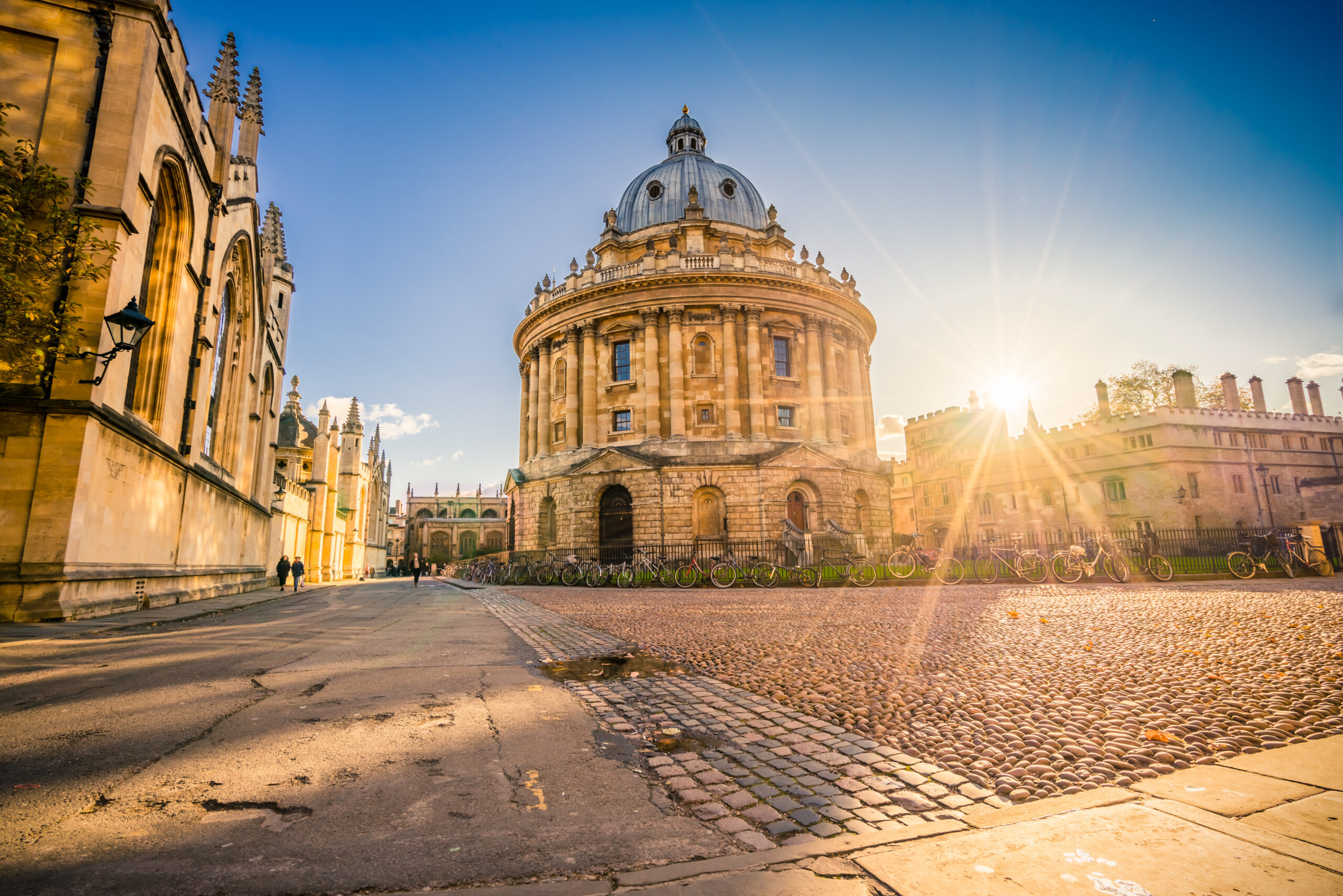Oxfordshire, nestled in the heart of southern England, is a county that embodies the richness of English culture, heritage, and natural beauty. Renowned worldwide for its ancient university, Oxfordshire is far more than an academic stronghold; it is a tapestry of market towns, historic villages, rolling countryside, and waterways that have inspired generations. Its landscape straddles the fertile Thames Valley, the wooded Chiltern Hills, and the limestone uplands of the Cotswolds, each contributing to a varied and enchanting geography.
At the county’s heart stands Oxford, the “City of Dreaming Spires,” where medieval colleges, libraries, and chapels form one of the most remarkable architectural ensembles in Europe. Yet Oxfordshire extends well beyond its famous university city. To the north, the Cotswold villages such as Burford, Chipping Norton, and Woodstock showcase honey-coloured stone cottages, vibrant markets, and timeless charm. To the south, Henley-on-Thames is celebrated for its rowing traditions, elegant riverside walks, and Georgian streets.
The county’s history is layered and deep. Prehistoric monuments, Roman roads, Norman castles, and grand country houses such as Blenheim Palace tell the story of a region that has been at the centre of English life for millennia. Churches and abbeys bear witness to centuries of spiritual devotion, while medieval towns reveal Oxfordshire’s role in trade and politics.
Nature thrives in Oxfordshire’s meadows, riverbanks, and woodland. The Thames Path meanders through its heart, offering serene vistas and tranquil walks. Wildlife reserves and commons preserve the county’s biodiversity, while the Chilterns and Cotswolds provide endless opportunities for exploration.
Oxfordshire is also a county of creativity. It has inspired writers from J.R.R. Tolkien to C.S. Lewis, and it remains a place where scholarship, art, and literature flourish. Festivals, theatres, and galleries enrich cultural life, while pubs and tearooms offer warm hospitality.
Taken together, Oxfordshire represents England in microcosm: scholarly yet rural, historic yet vibrant, traditional yet forward-looking. It is a county where past and present meet in landscapes and communities that continue to enchant visitors and residents alike.
Oxford – The City of Dreaming Spires

Oxford is not only the jewel of Oxfordshire but one of the most celebrated cities in the world. Known as the “City of Dreaming Spires,” it is dominated by the presence of the University of Oxford, the oldest in the English-speaking world. Its medieval colleges, cloisters, and libraries form a breathtaking cityscape where history and scholarship blend seamlessly.
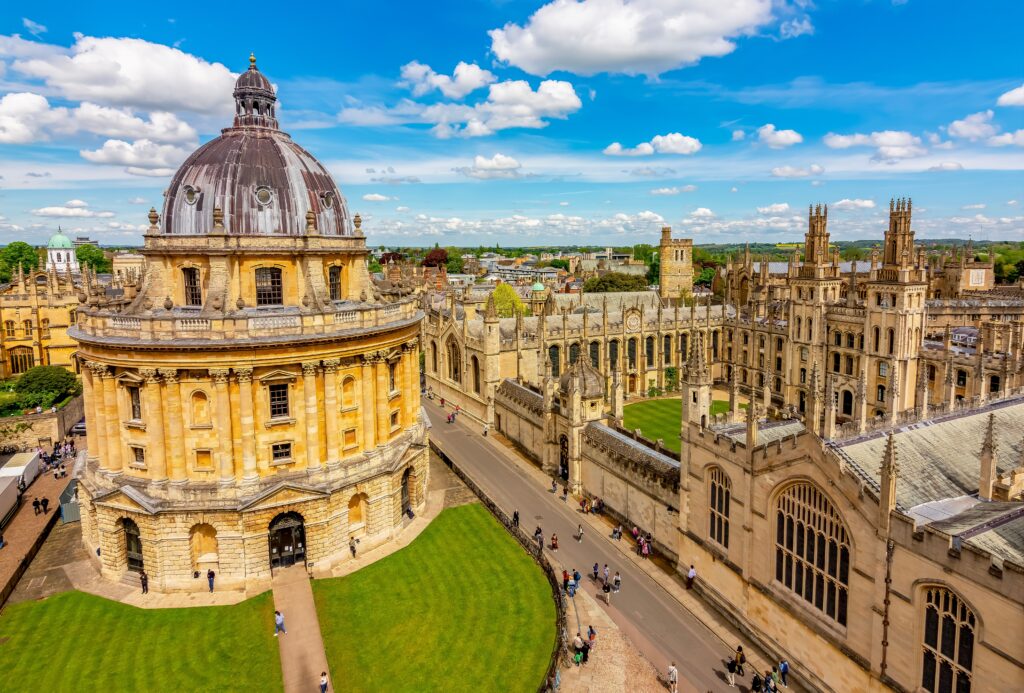
Among its most iconic sites are the Radcliffe Camera, the Bodleian Library, and the Sheldonian Theatre, each representing centuries of architectural excellence. The Christ Church Cathedral, doubling as the college chapel, offers grandeur on a scale rarely seen in university life. Cobbled streets, courtyards, and river walks enhance the city’s unique atmosphere.
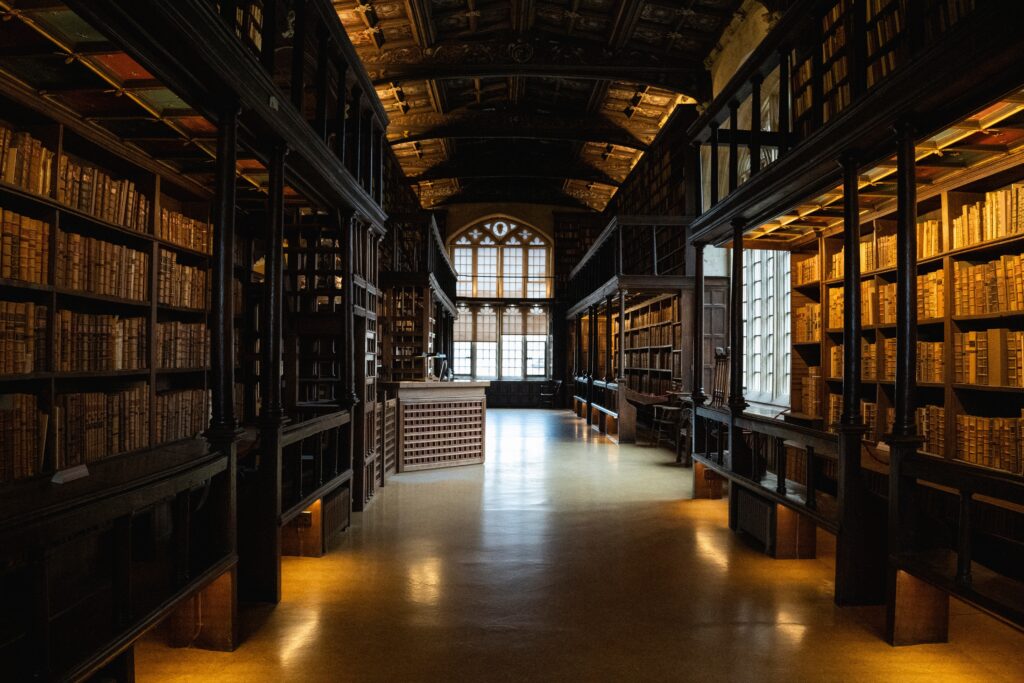
Beyond academia, Oxford has been a hub of culture and innovation. Writers such as Lewis Carroll, J.R.R. Tolkien, and C.S. Lewis found inspiration here, while filmmakers continue to use its historic streets and halls as backdrops. The Ashmolean Museum, Britain’s oldest public museum, and the Museum of Natural History add intellectual depth to the visitor experience.
Yet Oxford is also a living, breathing city. Bustling markets, bookshops, cafés, and pubs such as the Eagle and Child provide warmth and character. Punt boats drift along the Cherwell and Thames, giving students and visitors alike a quintessential Oxford experience.
Oxford embodies England’s intellectual and cultural heart, a city that continues to inspire the world.
Blenheim Palace
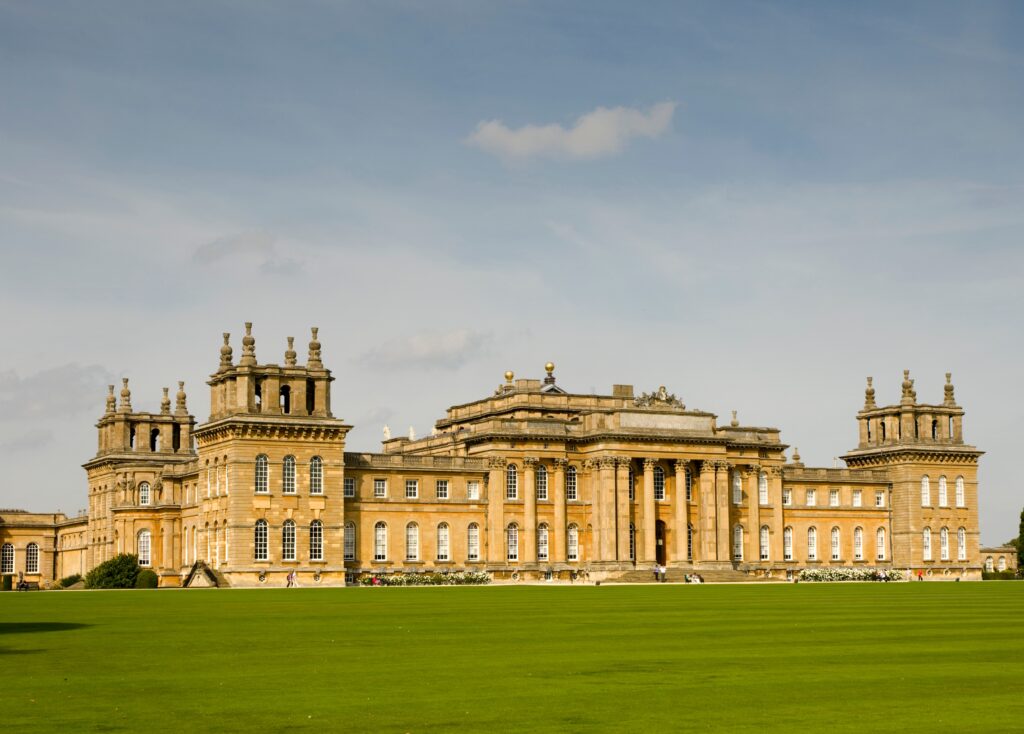
Located in Woodstock, Blenheim Palace is one of England’s grandest stately homes and a UNESCO World Heritage Site. Built in the early 18th century as a gift to John Churchill, 1st Duke of Marlborough, for his victory at the Battle of Blenheim, it represents the pinnacle of English Baroque architecture.
The palace is an awe-inspiring blend of history, art, and grandeur. Designed by Sir John Vanbrugh, its imposing façade, sweeping courtyards, and ornate interiors testify to its role as both a political symbol and a family seat. Visitors encounter opulent state rooms, filled with portraits, tapestries, and fine furnishings that reflect centuries of aristocratic life.

Blenheim is also famed as the birthplace of Sir Winston Churchill, who is memorialised throughout the estate. The Churchill Exhibition offers insight into his remarkable life, while the gardens and parkland, designed by the landscape genius Capability Brown, stretch across 2,000 acres of lakes, woods, and formal terraces.
The estate continues to host events, from concerts to horse trials, ensuring that Blenheim remains vibrant. It is not only a monument to power and heritage but also a place where nature, art, and history coexist in splendour.
Woodstock

The charming town of Woodstock sits just outside the gates of Blenheim Palace, its history deeply entwined with that of the estate. With roots stretching back to the Anglo-Saxon era, Woodstock developed into a bustling market town, and today it retains its historic character with stone houses, narrow streets, and an inviting atmosphere.

Woodstock’s Georgian façades, medieval inns, and traditional shops make it a delight to explore. The Oxfordshire Museum, housed in a 17th-century building, provides an engaging introduction to the county’s archaeology, natural history, and art. Nearby, the Soldiers of Oxfordshire Museum preserves the county’s military heritage.
The town’s inns and tearooms offer rest for travellers, while antique shops and galleries highlight Woodstock’s creative side. Its proximity to Blenheim ensures a steady flow of visitors, but Woodstock itself deserves appreciation for its independent spirit.
Woodstock blends heritage and charm, acting as both a gateway to Blenheim and a destination in its own right.
Burford

Known as the “Gateway to the Cotswolds,” Burford is one of Oxfordshire’s most picturesque towns. Its sloping high street, lined with medieval and Tudor buildings, leads down to the River Windrush, creating one of the most iconic views in the region.

Burford’s history as a prosperous wool town is evident in its impressive architecture. The Church of St John the Baptist, one of the grandest in Oxfordshire, reflects the wealth of medieval merchants, with elaborate tombs, a soaring tower, and intricate stonework. The church also bears witness to turbulent history, including the imprisonment of Leveller soldiers after the English Civil War.
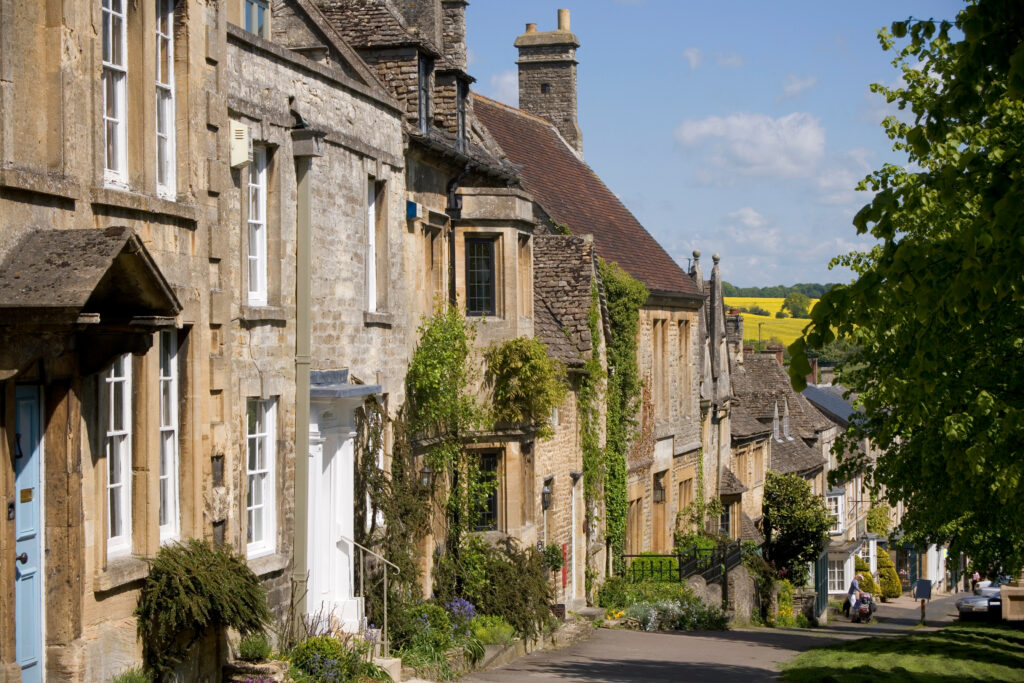
Today, Burford retains its charm with antique shops, tearooms, and independent boutiques. The Tolsey Museum, housed in a Tudor market hall, preserves local history and highlights the town’s role in trade and governance.
The surrounding countryside enhances Burford’s appeal, with rolling Cotswold hills and meadows providing a timeless backdrop. For visitors, Burford offers a perfect blend of history, architecture, and rural beauty—an archetype of the Cotswolds at its most enchanting.
Chipping Norton

Nestled in the Cotswold Hills, Chipping Norton is a vibrant market town with a history rooted in wool and textiles. Its name, meaning “market north town,” reflects its medieval role as a centre of commerce.
At its heart lies a traditional market square surrounded by historic buildings. The Church of St Mary the Virgin is a masterpiece of Cotswold Perpendicular Gothic architecture, with a magnificent tower and spacious interior built during the wool trade’s heyday.

Chipping Norton also played a role in the industrial revolution, with mills and workshops adding to its prosperity. The town later became a cultural hub, home to theatres, festivals, and a lively arts scene. Today, it retains that creative spirit, with the Theatre Chipping Norton serving as a hub for drama, film, and community events.
The town is also famous in contemporary culture as home to the “Chipping Norton set,” a group of politicians, journalists, and celebrities. Despite this, it remains firmly rooted in tradition, with bustling markets and Cotswold charm.
Henley-on-Thames

On the southern edge of Oxfordshire, Henley-on-Thames is synonymous with rowing and riverside elegance. Its Georgian streets, riverside setting, and cultural life make it one of the county’s most distinguished towns.
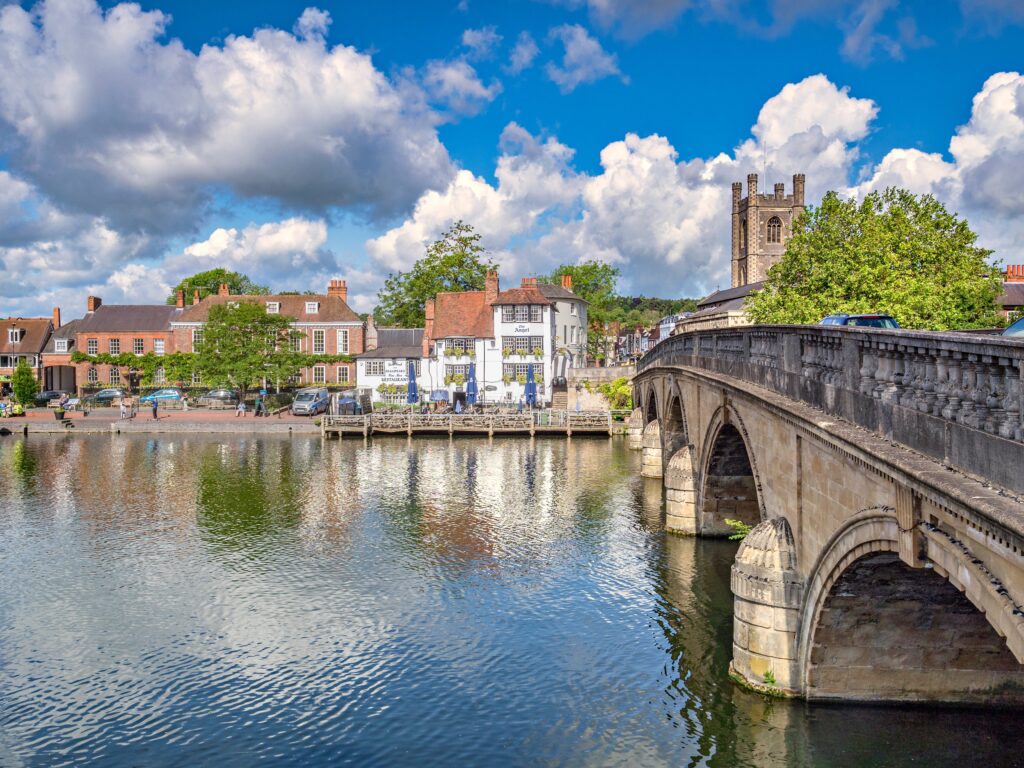
Henley is best known for the Henley Royal Regatta, established in 1839, which draws international competitors and spectators every summer. The event combines world-class sport with social prestige, turning the riverbank into a scene of tradition and style.
The town itself is equally appealing. The River and Rowing Museum explores the history of rowing, the Thames, and the world of Kenneth Grahame’s The Wind in the Willows. Henley’s bridge, dating to the 18th century, is a landmark, while the surrounding countryside of the Chiltern Hills provides a verdant backdrop.
Henley is also a town of festivals, hosting literary and music events that attract a cosmopolitan crowd. Its riverside pubs, restaurants, and shops add to its atmosphere of sophistication and relaxation.
With its blend of sport, history, and beauty, Henley-on-Thames is both quintessentially English and globally renowned.
Abingdon

Claiming to be one of the oldest continually inhabited towns in England, Abingdon-on-Thames is steeped in history. Once a Saxon settlement and later a medieval centre of religion, trade, and governance, Abingdon still showcases its layered past in its architecture and traditions.
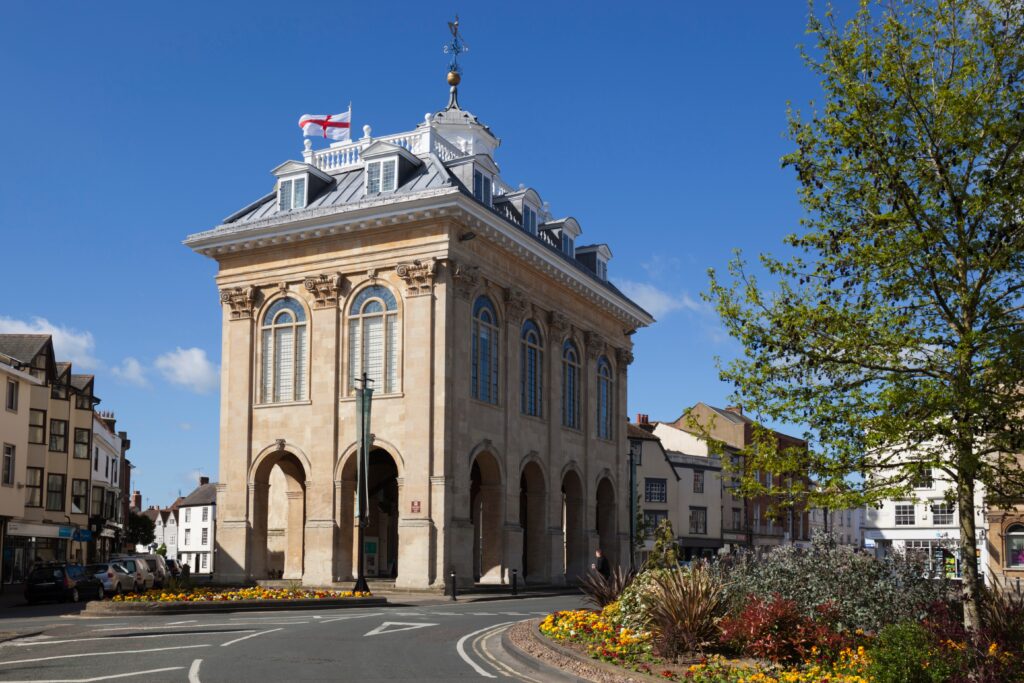
At its heart lies the Abingdon County Hall Museum, housed in a striking 17th-century Baroque building raised on arches, dominating the market square. The ruins of Abingdon Abbey, once among the wealthiest in the land, hint at the town’s medieval significance before its dissolution under Henry VIII.

The River Thames shapes Abingdon’s character, with riverside walks, meadows, and the graceful Abingdon Bridge providing scenic beauty. Rowing and boating remain popular, continuing a long association with river life.
Abingdon is also known for its ancient customs, including the ceremonial distribution of “bun throwing” from the roof of the County Hall during royal celebrations—a tradition that cements its unique identity. With its history, festivals, and riverside charm, Abingdon is one of Oxfordshire’s cultural treasures.
Wallingford

Set beside the Thames, Wallingford is a town with deep medieval roots and a proud place in English history. Its strategic location made it a stronghold in Saxon and Norman times, and the ruins of Wallingford Castle testify to its former importance. Once one of England’s greatest castles, it was dismantled after the Civil War, but its earthworks and remains still dominate the town.
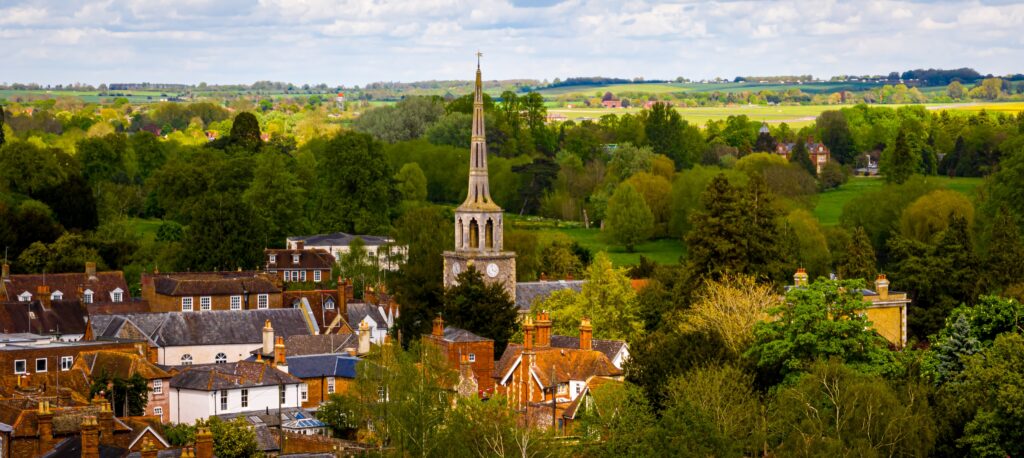
Wallingford flourished as a market town, with its broad market square and medieval bridge still central to its identity. Georgian and Victorian architecture adds to the townscape, while the Corn Exchange Theatre continues the tradition of cultural life.
The town is also associated with Agatha Christie, who lived nearby and is buried in Cholsey churchyard. Many of her detective stories drew inspiration from the landscape and atmosphere of the Thames Valley.
Today, Wallingford combines history with modern vitality, offering shops, cafés, and riverside walks. It remains one of Oxfordshire’s most characterful towns, balancing heritage and charm.
Thame

On the eastern edge of Oxfordshire lies Thame, a classic market town with a strong sense of identity. Its broad high street, lined with historic buildings, reflects centuries of prosperity. Timber-framed inns, Georgian facades, and Victorian structures create a rich architectural mix.
Thame’s market tradition continues, with weekly markets bringing life to the town centre. The Thame Museum explores local heritage, while the Church of St Mary the Virgin, with its impressive tower and spacious nave, highlights medieval craftsmanship.

The town is also known for its connections to literature and television. It frequently appears in the detective series Midsomer Murders, making it familiar to fans worldwide. Festivals and cultural events sustain its lively atmosphere, reinforcing Thame’s role as both a historic settlement and a modern community.
Surrounded by the rolling Chiltern Hills and farmland, Thame serves as a gateway between rural and urban Oxfordshire. Its balance of heritage, tradition, and vibrancy makes it a standout destination in the county.
Dorchester-on-Thames
Despite its modest size, Dorchester-on-Thames holds an outsized place in Oxfordshire’s history. Once the site of a Roman settlement, it later became an important centre of Christianity in Anglo-Saxon England.

The village’s crowning glory is the Dorchester Abbey, originally a Saxon cathedral and later an Augustinian abbey. Its vast, light-filled interior is remarkable for such a small village, containing medieval wall paintings, fine stained glass, and a unique Jesse window. Today, it serves as the parish church, while also housing a museum and tearoom that welcome visitors.
Dorchester is also rich in prehistoric heritage. Just outside the village lies the Dyke Hills, ancient earthworks that once guarded a significant river crossing. The nearby confluence of the Thames and Thame rivers creates a pastoral setting of meadows and waterways.
With its abbey, archaeology, and riverside walks, Dorchester-on-Thames is both a place of peace and a gateway into England’s early story.
Bampton

The charming village of Bampton is widely recognised today as a filming location for the television series Downton Abbey, where it stood in as the fictional village. Yet its appeal stretches far beyond its cinematic fame.
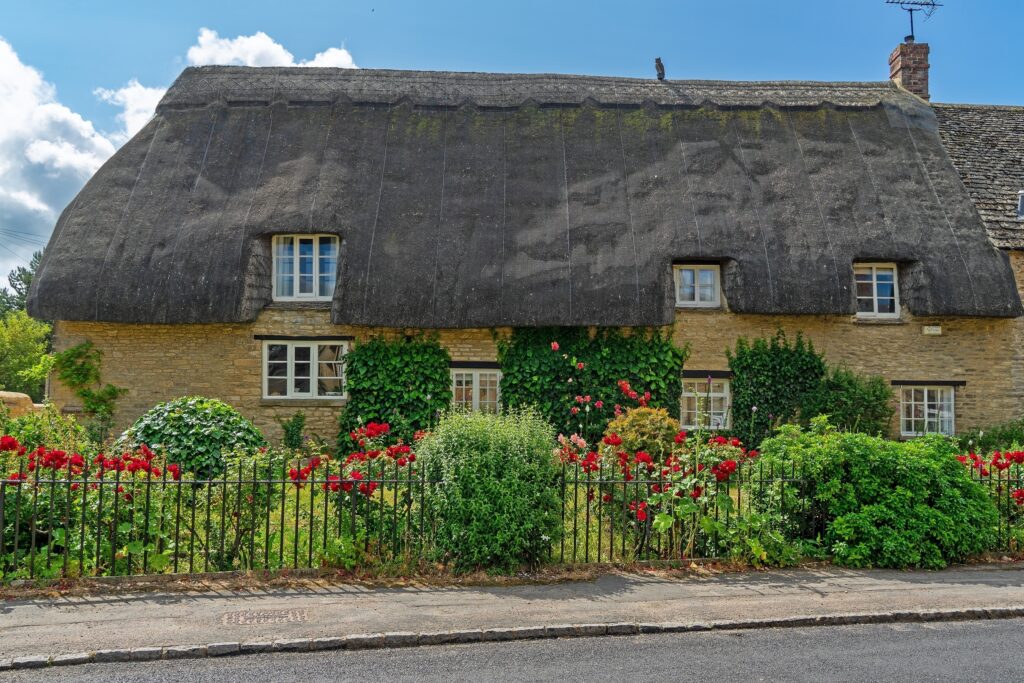
At its heart lies the impressive Church of St Mary the Virgin, one of the largest parish churches in Oxfordshire, with a tall spire and rich medieval features. The churchyard and surrounding cottages, often seen on screen, highlight the village’s timeless character.
Bampton also boasts a long tradition of folk culture. The village is one of the few places in England where Morris dancing has been continuously practised for centuries. Its annual Whit Monday celebrations draw visitors eager to see this colourful display of music and dance.
With its historic architecture, lively traditions, and cultural resonance, Bampton captures both the intimacy of rural Oxfordshire and the breadth of English heritage.
Eynsham
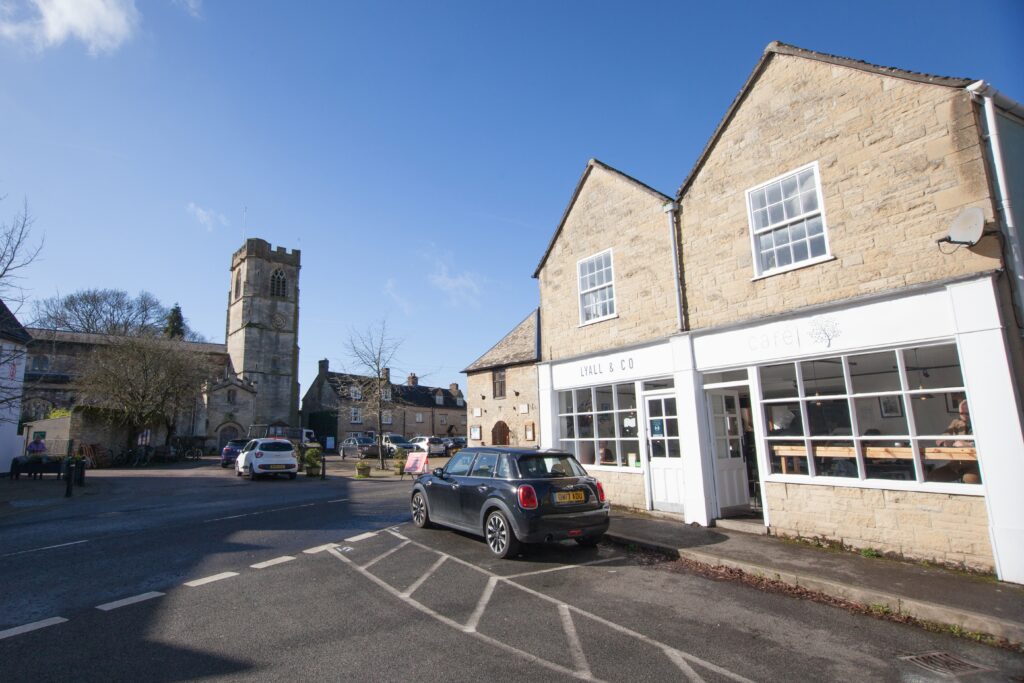
Located near Oxford, Eynsham is a large village with ancient origins and a strong community spirit. Once the site of a great Benedictine abbey, founded in the 11th century, Eynsham retains echoes of its monastic past in street names and archaeological remains.
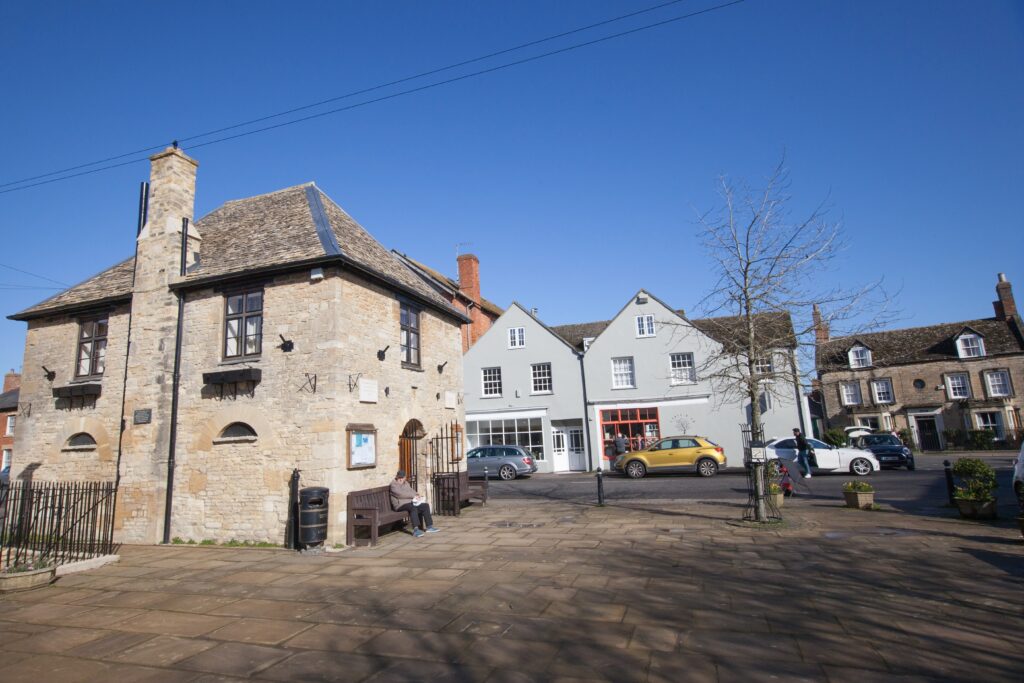
The parish church of St Leonard reflects both Norman and later Gothic craftsmanship, while the village centre retains a mixture of historic buildings. Eynsham’s market tradition continues through fairs and events that bring people together.
The village also enjoys a beautiful setting by the Thames and the Oxford Canal, offering opportunities for walking, cycling, and exploring. Its proximity to Oxford makes it a desirable place to live, while it remains distinct in character.
Eynsham exemplifies the blend of heritage and modern life found throughout Oxfordshire: rooted in history, yet dynamic and welcoming.
Witney
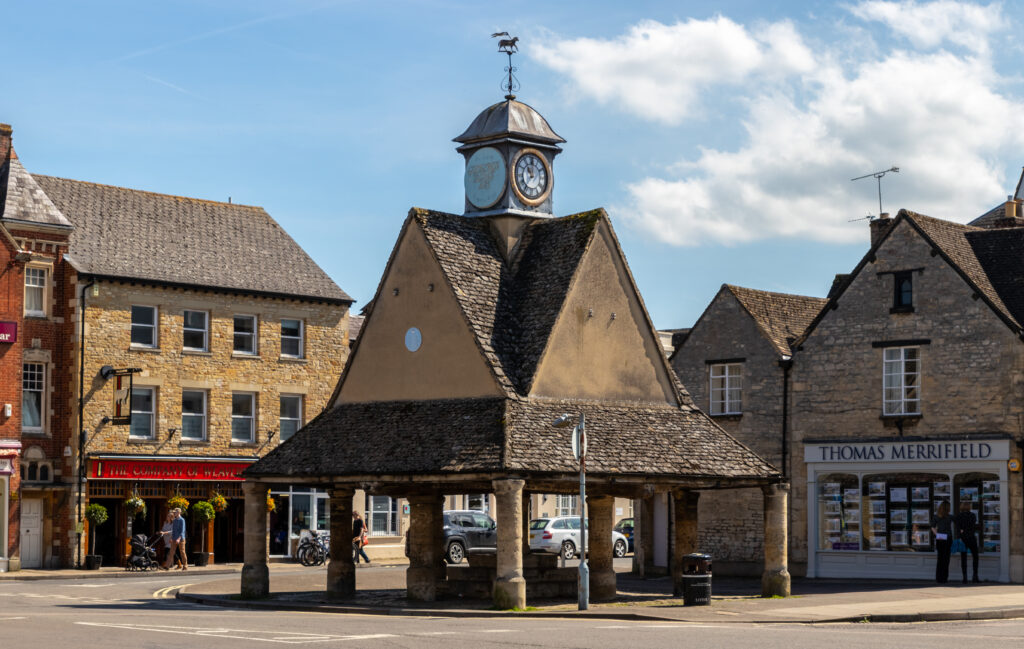
Long known as the centre of England’s blanket-making industry, Witney is a bustling market town with deep historic and industrial roots. Its name is synonymous with the “Witney Blanket,” a product exported worldwide from medieval times until the 20th century.
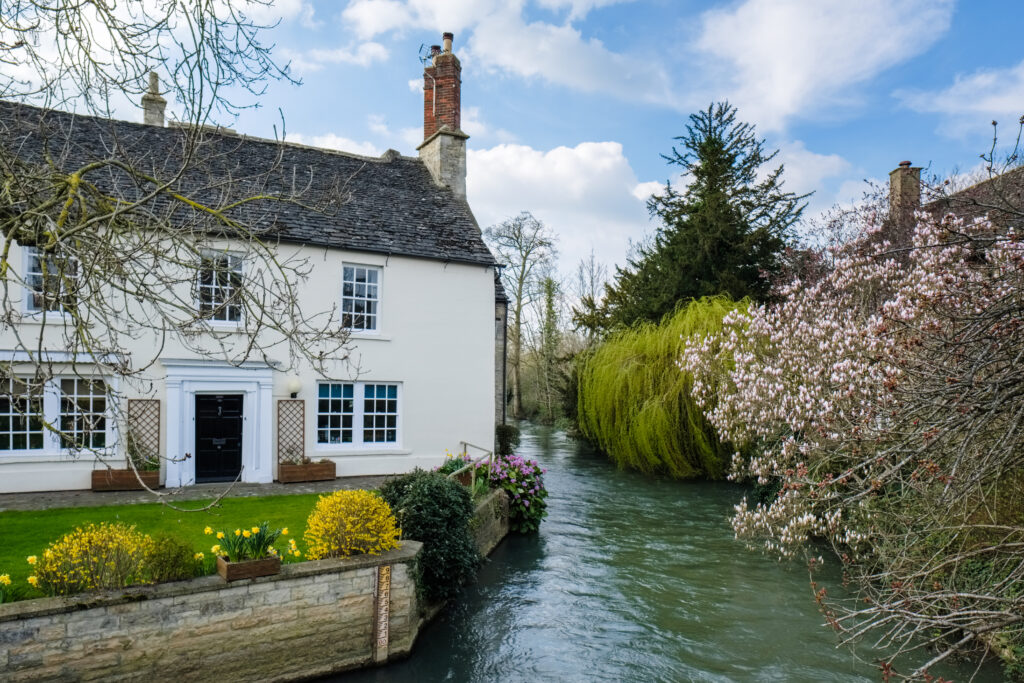
The town’s heritage is preserved in the Witney Blanket Hall, originally built in the 18th century as the meeting place of the powerful Company of Blanket Makers. Today, it serves as a museum and tea room, telling the story of an industry that shaped the town for centuries.
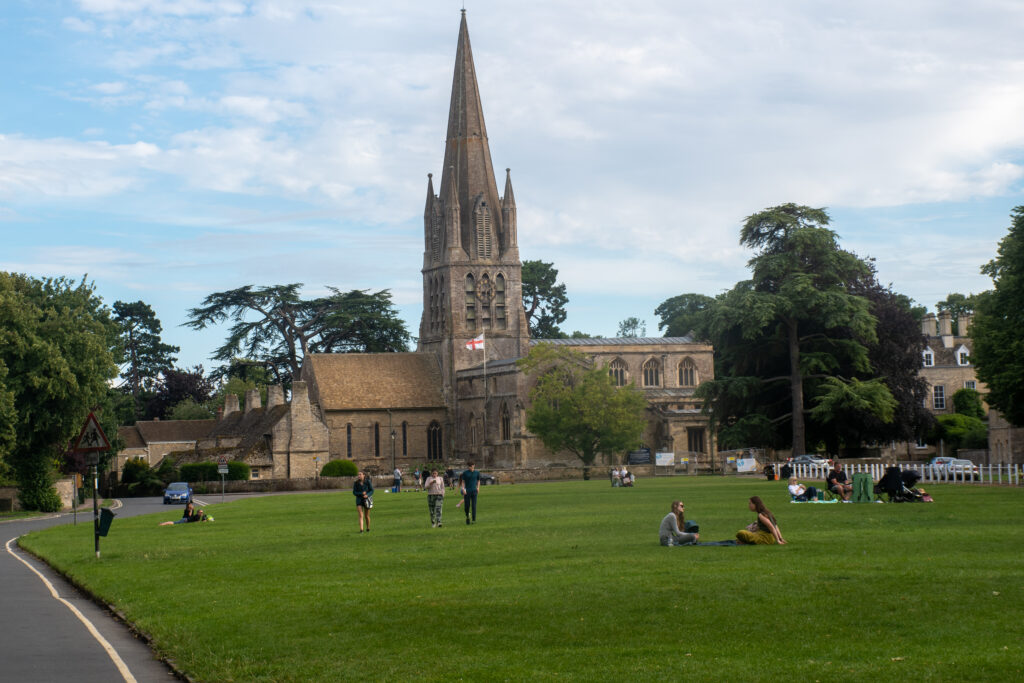
The spacious Market Square is framed by handsome buildings, including the 17th-century Buttercross, where dairy produce was once traded. The parish Church of St Mary the Virgin, with its striking spire, dominates the skyline and reflects the prosperity of past centuries.
Witney remains lively, with a strong community spirit, markets, and modern amenities. Blending industrial heritage with vibrant present-day life, it exemplifies Oxfordshire’s mix of tradition and progress.
Banbury
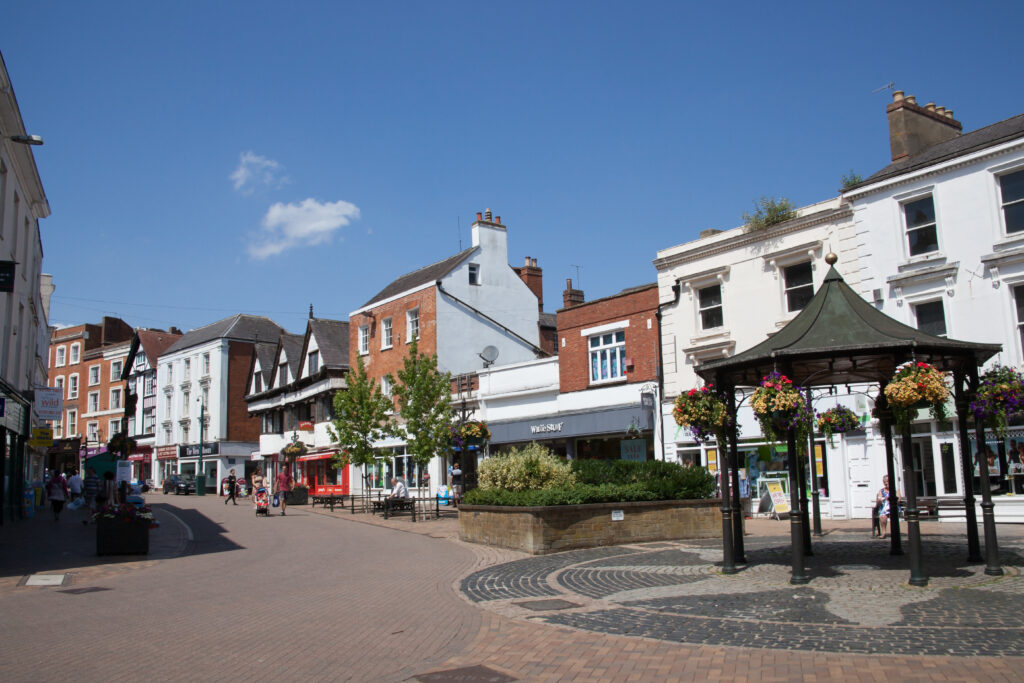
Straddling the River Cherwell, Banbury is one of Oxfordshire’s largest towns, with a heritage of trade, industry, and folklore. Famous for the nursery rhyme “Ride a Cock Horse to Banbury Cross,” the town retains its historic charm while embracing modern growth.
The Banbury Cross itself, a Victorian monument, commemorates the town’s long history, while the medieval St Mary’s Church adds spiritual gravitas. Banbury flourished as a market and coaching town, with its location on the Oxford Canal boosting trade in the 18th and 19th centuries.
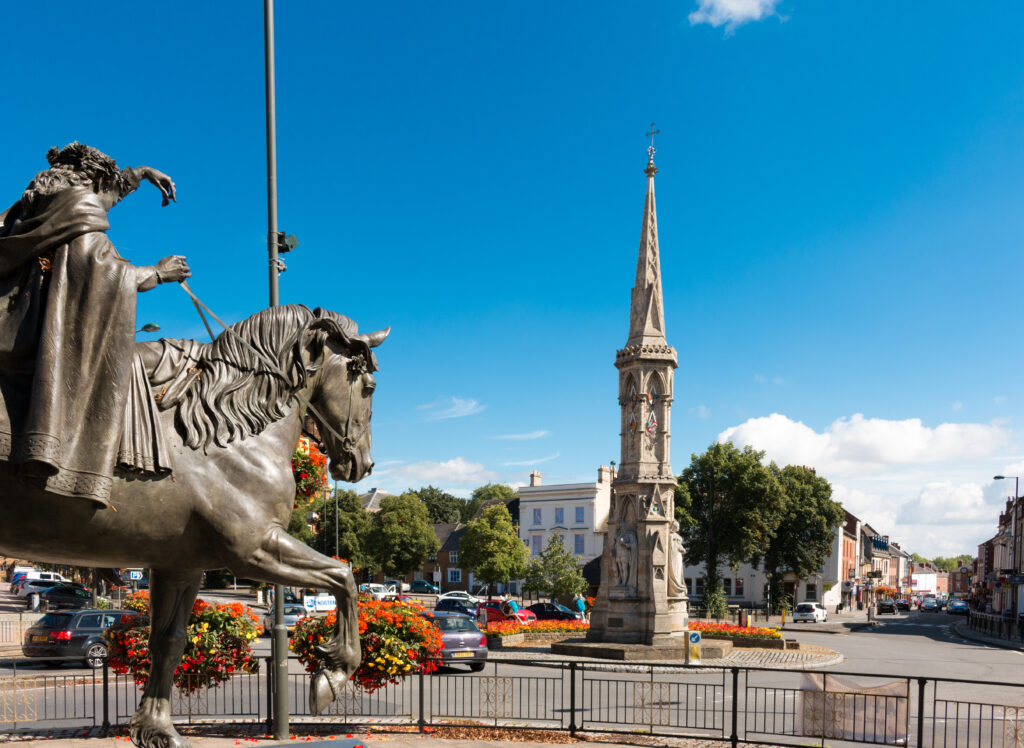
Banbury is also known for its culinary tradition: the Banbury cake, a spiced pastry filled with currants, remains a regional specialty. The town’s Museum and Tooley’s Boatyard highlight its waterways and industrial story.
Today, Banbury combines historic streets and markets with modern shopping and culture, making it one of Oxfordshire’s most dynamic towns.
Faringdon

On the western edge of Oxfordshire lies Faringdon, a market town full of character and quirks. Its name means “fern-covered hill,” a fitting description for a settlement that has always looked out across fertile countryside.

The town’s focal point is the Market Place, with its historic Town Hall and a statue of Lord Berners, an eccentric 20th-century nobleman known for his colourful character and artistic patronage. He famously dyed pigeons bright colours and left behind a legacy of whimsy that still flavours the town’s identity.

Nearby stands the Faringdon Folly Tower, a 140-foot landmark built by Lord Berners in 1935. Surrounded by woodland, it offers panoramic views across three counties and has become a beloved symbol of the town.
With its mix of history, eccentricity, and community life, Faringdon is a small town with a big personality—an Oxfordshire gem not to be overlooked.
Goring & Streatley

Straddling the Thames where Oxfordshire meets Berkshire, the twin villages of Goring and Streatley are linked by a bridge and bound together by their idyllic riverside setting. Nestled between the Chiltern Hills and the Berkshire Downs, this spot has been designated part of the Goring Gap—an area of outstanding natural beauty carved by the river.
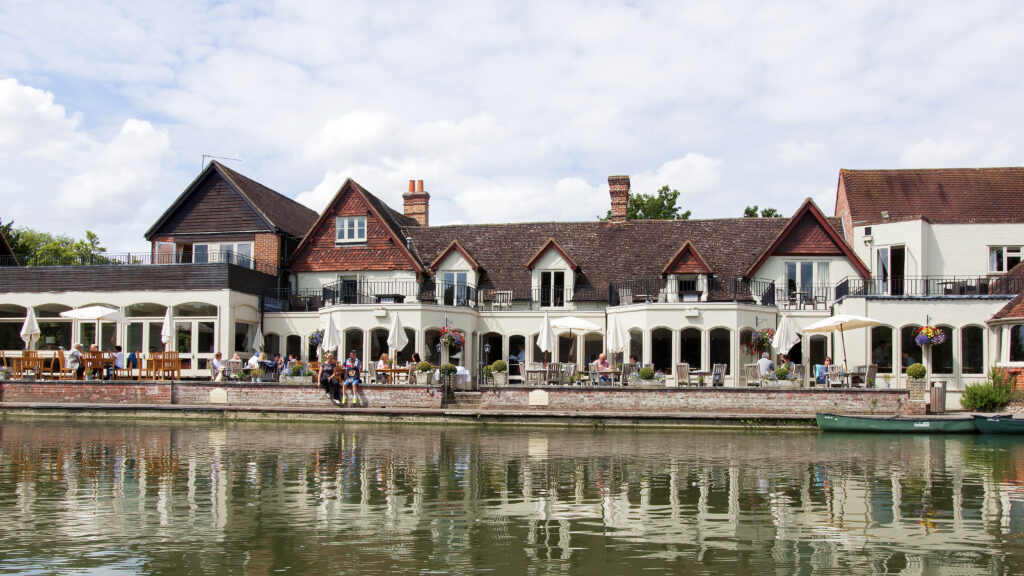
The villages are celebrated for their charm: Goring with its flint cottages and riverside pubs, and Streatley with its historic coaching inns. Together, they offer an atmosphere of timeless English countryside, while still being within easy reach of London.
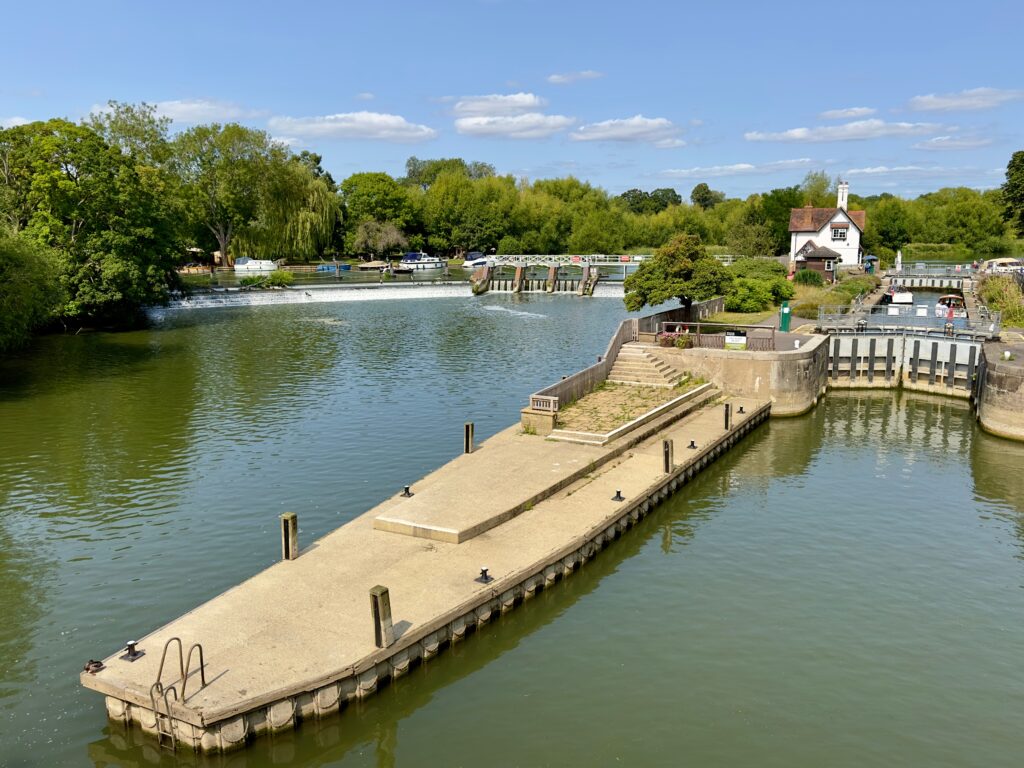
This is also a place of literary and artistic associations. Jerome K. Jerome’s Three Men in a Boat captured the spirit of Thames leisure here, and the area remains popular with walkers, rowers, and nature lovers.
With scenic trails, boating, and a quintessential riverside charm, Goring & Streatley represent the peaceful beauty of Oxfordshire’s borderlands.
Charlbury

Set in the heart of the Cotswolds, the town of Charlbury combines honey-coloured stone buildings with a lively community spirit. Once a centre of glove-making, it has evolved into a vibrant hub for culture and countryside life.
The town’s historic core is filled with traditional cottages, independent shops, and cosy pubs. Its surroundings include Cornbury Park, an estate with deep royal and aristocratic connections, which also hosts modern music and arts festivals, blending tradition with contemporary creativity.
Charlbury is also noted for its railway links, making it a gateway to exploring the wider Cotswolds and Oxfordshire countryside. Walking and cycling routes connect it to scenic valleys, woodlands, and villages.
With its balance of history, craftsmanship, and cultural vibrancy, Charlbury offers both heritage charm and a modern sense of community—an Oxfordshire town that embodies the spirit of the Cotswolds.
Shipton-under-Wychwood

Nestled in the Evenlode Valley, Shipton-under-Wychwood is one of the historic Wychwood villages, named after the once-great royal forest that surrounded them. Today, it retains the charm of a traditional English village, with a rich mix of history and rural beauty.
At the centre stands the Church of St Mary the Virgin, a large and impressive building for such a small place. Its medieval architecture and spacious interior reflect the importance of the settlement in centuries past. The churchyard is also noted for its atmosphere and historic memorials.
Shipton-under-Wychwood is a place of quiet traditions and community life, with welcoming pubs, village greens, and walks leading into the surrounding countryside. Its setting on the edge of the Cotswolds enhances its beauty, making it a perfect base for exploring the region.
Though smaller than its more famous neighbours, Shipton-under-Wychwood embodies the essence of the Oxfordshire countryside—peaceful, historic, and deeply rooted in the land.
Burghclere (near Oxfordshire’s edge)
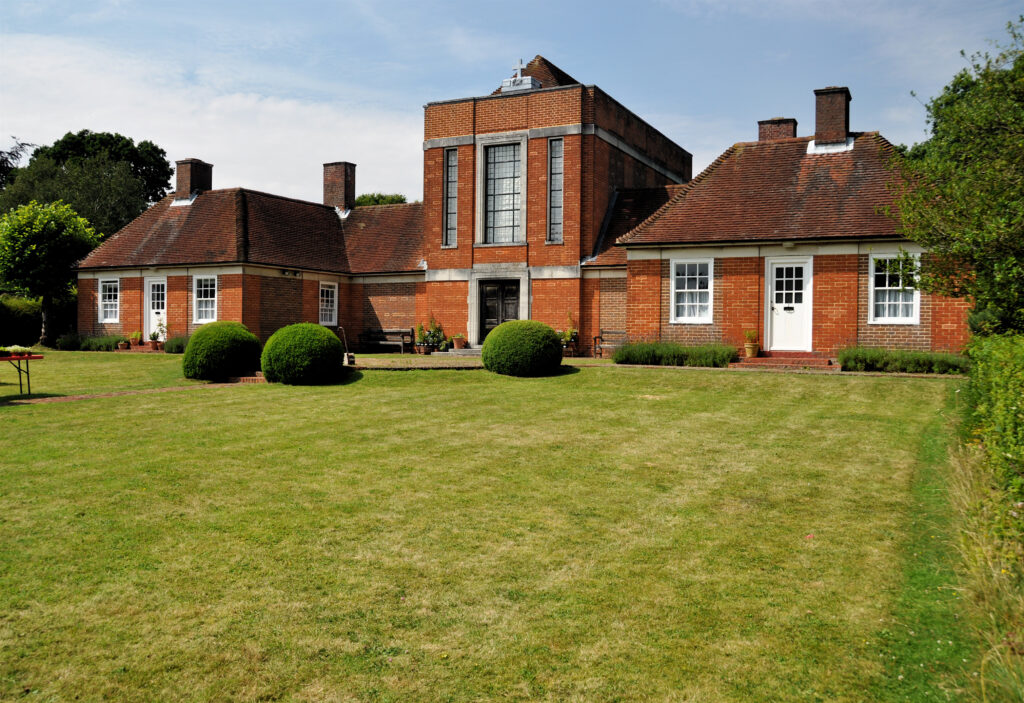
Although just over the county border in Hampshire, Burghclere is closely linked with Oxfordshire’s cultural landscape thanks to the world-renowned Sandham Memorial Chapel. Designed by architect Lionel Pearson and adorned with vast murals by Sir Stanley Spencer, the chapel is one of the most moving war memorials in Britain.
Spencer’s paintings, inspired by his own service in the First World War, depict everyday scenes of military life with extraordinary detail and humanity. The cycle is often compared to Giotto’s frescoes in Padua, a testament to its power and artistry.
Burghclere itself is a charming rural village, with scenic walks and traditional English countryside character. Its proximity to Oxfordshire means it often features in cultural itineraries of the wider Thames Valley region.
Though small, Burghclere’s impact on British art and memory is immense, making it a cultural stop of rare significance.
Kidlington
Just north of Oxford lies Kidlington, reputedly one of the largest villages in England. Despite its size, it has retained much of its village character, with green spaces, historic churches, and a strong sense of community.
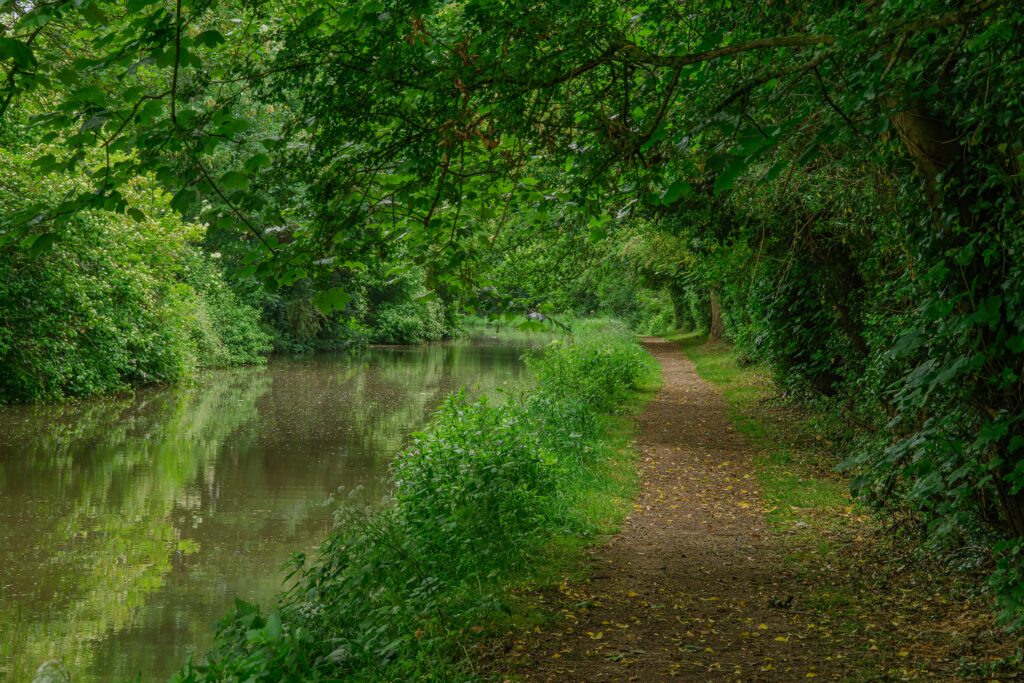
The Church of St Mary the Virgin, with its striking spire, is a landmark that has stood for centuries. The River Cherwell flows nearby, adding to the area’s pastoral beauty, while the Oxford Canal runs along its edge, offering scenic walks and boating opportunities.
Kidlington has grown substantially in recent decades, blending modern housing and amenities with its older core. Yet it remains distinct, hosting fairs, markets, and events that maintain its communal identity.
As a place where tradition meets modern life, Kidlington embodies the evolution of Oxfordshire’s villages into thriving, diverse communities.
Bicester

Bicester is a town that bridges the gap between Oxfordshire’s history and its modern, international presence. Traditionally a market town with Saxon origins, it has grown into one of the fastest-expanding towns in southern England.
Its historic heart centres on St Edburg’s Church and the old town area, where narrow lanes and period buildings reflect its long past. Markets and fairs remain part of Bicester’s identity, continuing a tradition stretching back centuries.
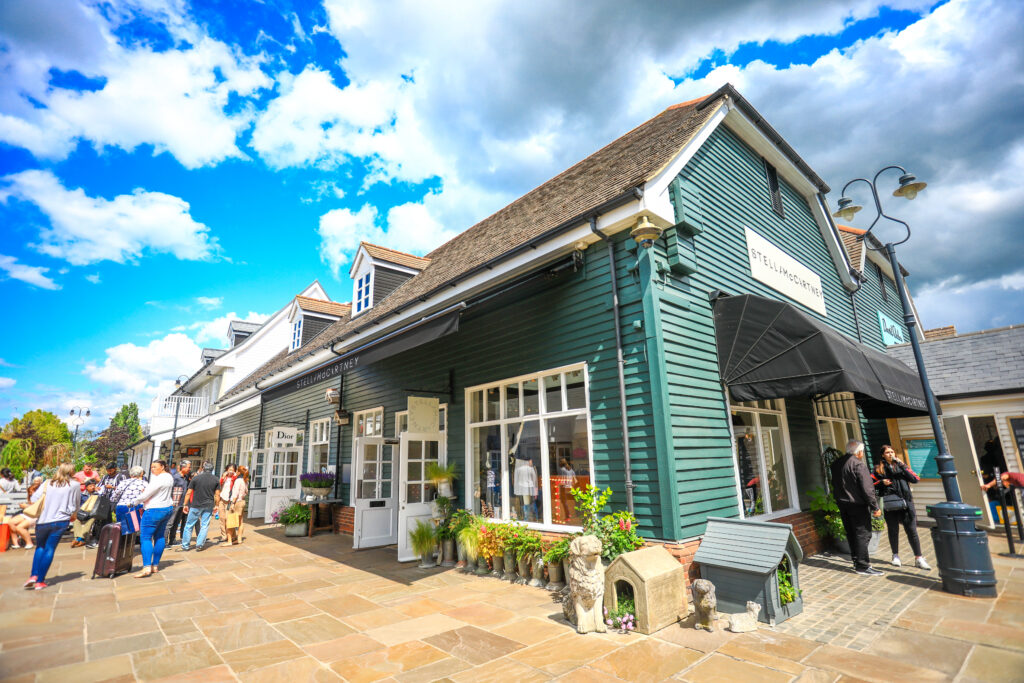
Yet today, Bicester is globally known for Bicester Village, a luxury shopping destination that draws millions of visitors each year. Offering designer brands in a village-style setting, it has transformed the town into a major international attraction.
With its balance of old and new, Bicester represents Oxfordshire’s evolution: rooted in history but open to global connections and contemporary life.
Didcot
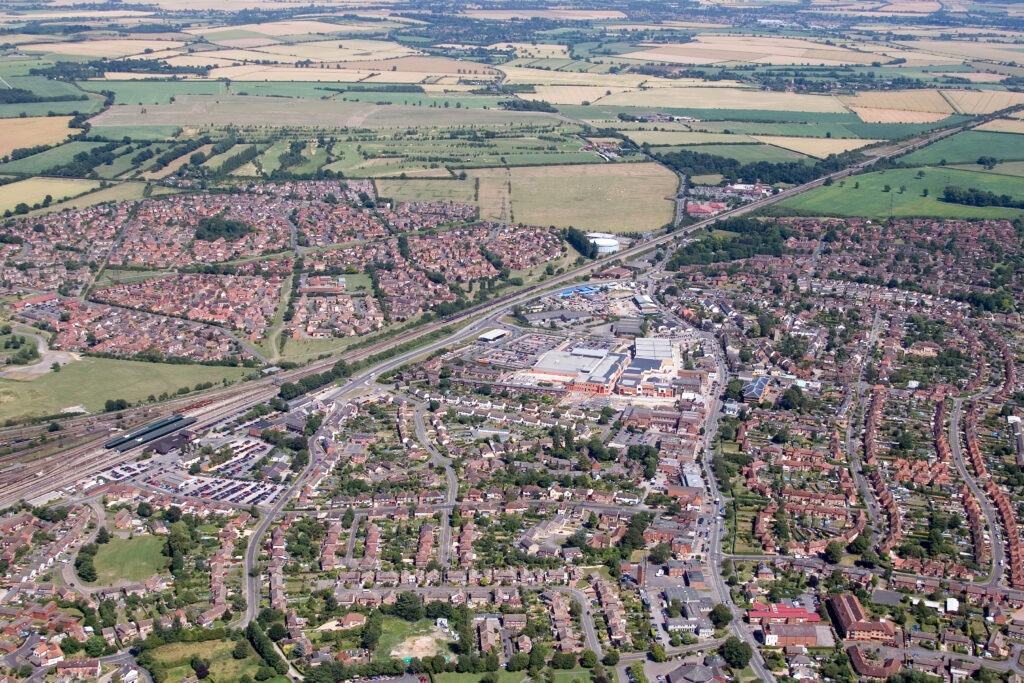
For much of its history, Didcot was a small agricultural village, but the arrival of the Great Western Railway in the 19th century transformed it into a key junction town. Railways remain central to its identity, celebrated at the Didcot Railway Centre, where visitors can explore steam locomotives, historic carriages, and railway heritage.

Didcot has also been shaped by its role in Britain’s energy story. The now-demolished Didcot Power Station towers once dominated the skyline, making the town a landmark of modern industry. Today, regeneration and new housing developments reflect its rapid growth and changing role.
Despite its industrial reputation, Didcot also has green spaces such as Mowbray Fields Nature Reserve and easy access to the surrounding countryside. It is increasingly seen as both a commuter town for Oxford and London and a community with its own evolving identity.
Didcot embodies transformation—shaped by trains, industry, and change, yet firmly part of Oxfordshire’s past and future.
Wantage

The market town of Wantage is forever tied to one of England’s greatest historical figures: King Alfred the Great, who was born here in 849. A statue in the market square commemorates the monarch who defended England against Viking invasions and championed learning and law.

Wantage’s medieval prosperity grew from agriculture and markets, and its Market Place remains the heart of the town. The Vale and Downland Museum tells the story of local heritage, from prehistory to the modern era, while the surrounding Vale of White Horse provides a dramatic landscape of hills and chalk downs.
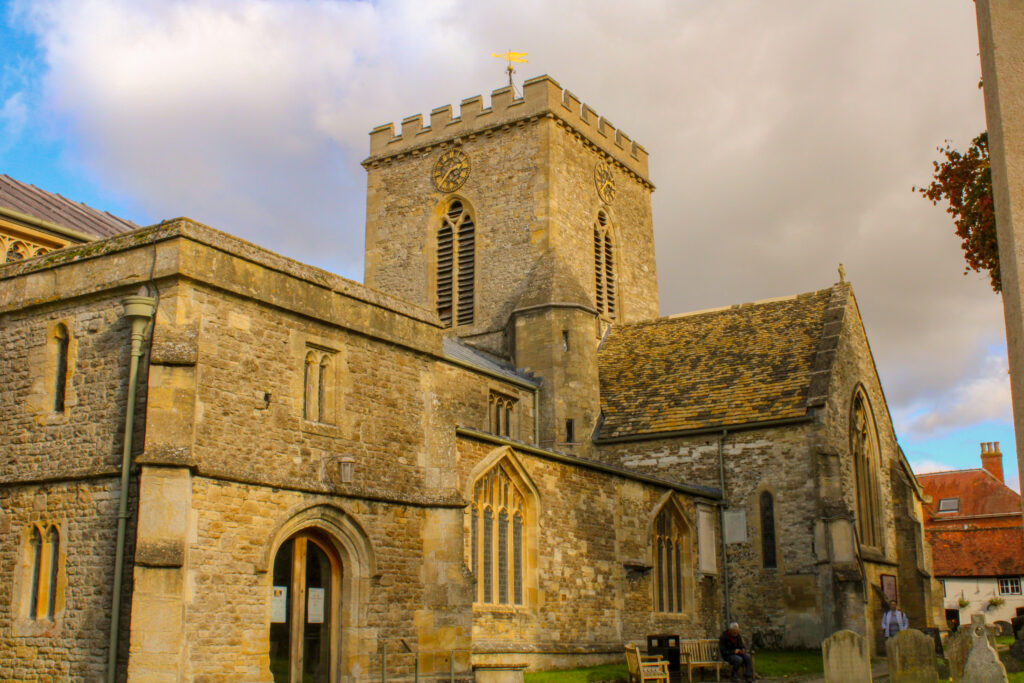
The Church of St Peter and St Paul dominates the town with its history and architecture, adding spiritual depth to Wantage’s character. Festivals, markets, and community traditions continue to give the town vitality.
Wantage is more than just Alfred’s birthplace—it is a living town where history and community life blend seamlessly.
Benson

Set on the River Thames, Benson is a picturesque village with a long history as a river crossing and trading point. Its strategic location made it important from Saxon times onward, and it has maintained its riverside charm ever since.
The Church of St Helen reflects centuries of local faith, while riverside inns and boat moorings highlight Benson’s connection to the Thames. Walking along the river here offers a quintessentially English experience, with meadows, wildlife, and timeless views.
Benson also has a strong aviation heritage, as home to RAF Benson, a key Royal Air Force station since 1939. Its presence has tied the village to both military history and modern service life.
Blending riverside tranquility with living history, Benson offers a snapshot of Oxfordshire’s deep and varied heritage.
Great Tew

The village of Great Tew is a Cotswold jewel, renowned for its honey-coloured stone cottages, thatched roofs, and idyllic setting. Yet beneath its picture-perfect exterior lies a rich and sometimes turbulent history.

Once part of a great estate, Great Tew has connections to key moments in England’s political and cultural life. In the 17th century, it was home to the “Great Tew Circle,” a group of philosophers, poets, and theologians who shaped intellectual thought in the years before the Civil War.
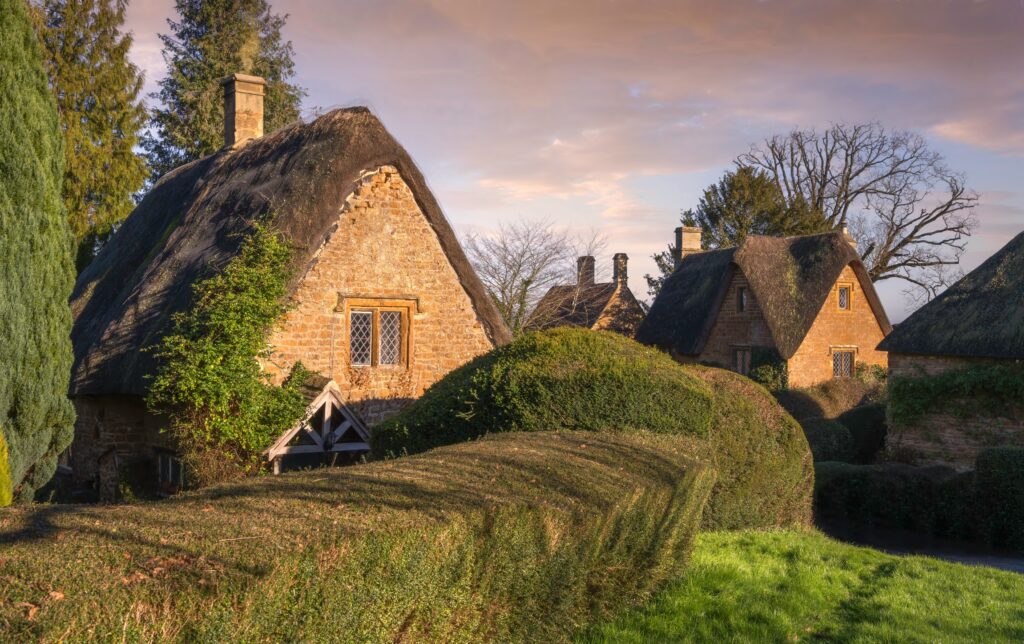
Today, the estate and village are carefully preserved, with a timeless character that draws visitors. The Great Tew Park hosts events such as music festivals, bringing contemporary vibrancy to historic surroundings.
With its mix of heritage, beauty, and cultural resonance, Great Tew stands as one of Oxfordshire’s most enchanting villages—a fitting close to the county’s top 30 highlights.

